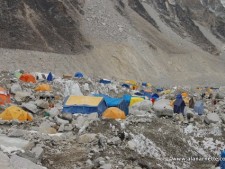Everest (Chinese) Basecamp (5,200 m / 17,000 feet)
I stumbled upon this trek map (see below) - probably not even close to the route we will take via bus. I loved the typos on the map. You can see the original at this website.
A better picture of a real map comes from our ol' reliable Google Maps. Here is an annotated screen shot of the Tibet map courtesy of google maps. I added the blue line since they would not provide distance or ETA.
Mark Horrell provided an interesting glimpse of the "road" the bus travels upon with this photo:
Looks like an interesting graded road. Note the sarcasm. That would be one boring trek - the Tibetan equivalent to treking I-10 across Texas. Sheesh! My suspicion is that we will all rejoice when we exit that bus for the glacier. Give me a lumpy tent over a bumpy, washboard laden road any day. When we arrive at basecamp, we have many options - some optional but strongly encouraged and others not terribly optional. The first views of Chinese basecamp look like this (courtesy of Alan Arnette):
The things we ought to do while at Chinese basecamp are....
Mark Horrell provided an interesting glimpse of the "road" the bus travels upon with this photo:
Looks like an interesting graded road. Note the sarcasm. That would be one boring trek - the Tibetan equivalent to treking I-10 across Texas. Sheesh! My suspicion is that we will all rejoice when we exit that bus for the glacier. Give me a lumpy tent over a bumpy, washboard laden road any day. When we arrive at basecamp, we have many options - some optional but strongly encouraged and others not terribly optional. The first views of Chinese basecamp look like this (courtesy of Alan Arnette):
The things we ought to do while at Chinese basecamp are....
- Rest. Yes, time to rest after shuttling ourselves across countless miles of washboard and dust-riddled roads. Hopefully the weather remains dry to it is dusty. I cannot imagine what those roads would be like if it were raining. We rest up and start to acclimatize at 17,000 feet. The last time I got up to this elevation was on Denali in 2011. That climb was an 11-hour ordeal where I had to help a fellow climber up from 15,000 feet and the 2,200 vertical feet took us 11 hours! Yep, it was not fun. To make matters worse, Mother Nature was pitching a fit - blowing gusts at us along a ridge at about 50 mph. I was not happy. Reuniting with 17,000 feet via bus ought to be much more relaxing but I think we will need rest anyway. Speaking of Denali, I recovered in a day from that ordeal and was ready to climb further after a 20 hour rest.
- Organize Equipment. Yep, another equipment sorting along with supplies. These steps are necessary for almost every expedition - whether the style qualifies as old military assault or fast and light. You never want to haul things up the mountain you don't need. Repacking allows you to make sure you have your necessities and leave behind all the optional items that just weigh you down and slow you down.
- Hike to the Rongbuk Monastery. The monastery is the highest in the world - originating in medieval times and currently active. Reminds me of a description of a volcano but far more peaceful (I hope). The picture below shows the monastery along with the views of Everest in the background. Notice we are getting closer but still far far away from the summit.
- Participate in a Buddhist Puja ceremony. These ceremonies are traditional rituals for Buddhists and become the staple for all visitors who seek to climb Everest (or any other mountain in the region). It doesn't really matter if you are a believer or not; you just do it. The old saying that there are no atheists on death row can be extended to...there are no non-Buddhists on Everest. Count me among them. Any help - be it imagined, conjured, or real - I welcome. Puja ceremonies invites blessing for the participants. Perhaps the ceremony may include permission to climb Chomolungma (Tibetan word for Mt. Everest). Here is a picture (courtesy of Learn NC) of a puja ceremony:
- Acclimatize. Lastly, the most important point to this stop is to continue to acclimatize. If we were already adapted to the altitude, we could trudge up without worry. Most of us will barely tolerate the new, hypoxic levels so we must take our time. While acclimatizing, it is best to walk around and exercise a bit - not too much but enough to keep the blood flowing and enough to ward off going stir crazy in a tent.







No comments:
Post a Comment